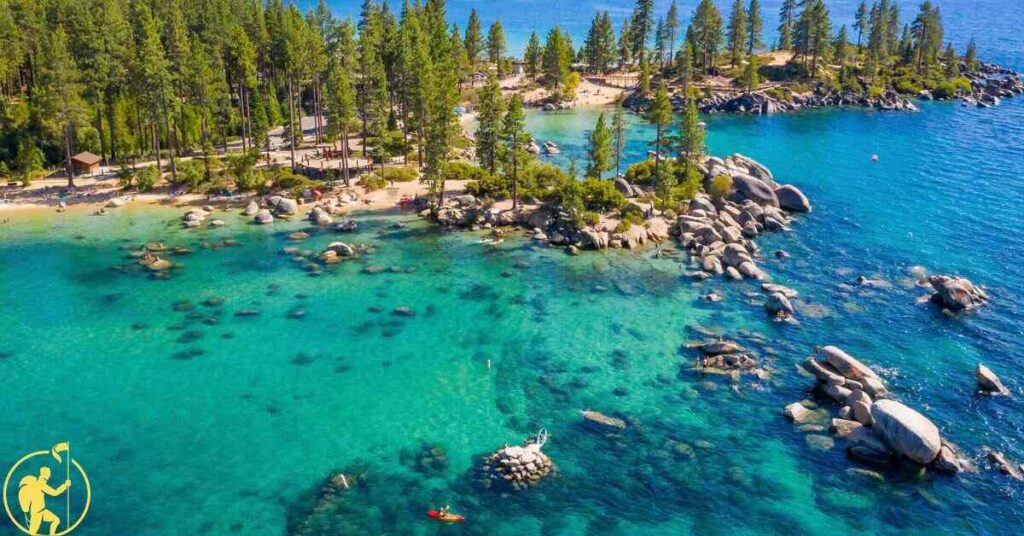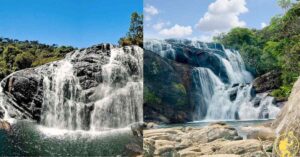Lake Tahoe, a name that evokes images of crystal-clear waters nestled among towering pine-covered mountains, is a natural wonder that has captivated visitors and residents alike for centuries.
Straddling the border between California and Nevada in the majestic Sierra Nevada mountain range, Lake Tahoe is renowned not only for its beauty but also for its unique geographical and ecological characteristics. One of the most frequently asked questions about this alpine gem is: “What is the elevation of Lake Tahoe?”
This comprehensive guide will delve deep into the answer to this question and explore many other fascinating aspects of this remarkable body of water.
Introduction to Lake Tahoe
Situated in the heart of the Sierra Nevada, Lake Tahoe is a freshwater lake of superlatives. It is the largest alpine lake in North America and the second deepest in the United States, surpassed only by Crater Lake in Oregon. The lake’s striking blue waters and surrounding snow-capped peaks have made it a year-round destination for nature lovers, outdoor enthusiasts, and those seeking respite from the hustle and bustle of urban life.
Geographical Setting of Lake Tahoe
Lake Tahoe occupies a fault basin that was formed millions of years ago through a combination of volcanic activity and glacial action. The lake is surrounded by the Carson Range to the east and the main Sierra Nevada range to the west. This unique setting contributes to the lake’s remarkable clarity and the diverse ecosystem that thrives in and around its waters.
Lake Tahoe’s Unique Features
Beyond its stunning visual appeal, Lake Tahoe boasts several characteristics that set it apart from other lakes worldwide. Its water clarity is legendary, with visibility depths that can exceed 70 feet in some areas. The lake’s size, depth, and elevation combine to create a unique microclimate that influences weather patterns and supports a rich variety of plant and animal life.
The Elevation of Lake Tahoe
Now, to address the central question of this article: What is the elevation of Lake Tahoe? The surface of Lake Tahoe sits at an impressive elevation of 6,223 feet (1,897 meters) above sea level. This high-altitude location contributes significantly to the lake’s character and ecological makeup.
Measuring Lake Tahoe’s Elevation
The elevation of Lake Tahoe is not a static figure. It is measured regularly using advanced surveying techniques and GPS technology. The reference point for these measurements is typically the lake’s natural rim, which is the level at which water would begin to flow into the Truckee River, the lake’s only outlet. The natural rim is located at 6,223 feet above sea level, while the maximum legal limit for the lake’s water level is set at 6,229.1 feet.
Factors Affecting Lake Tahoe’s Elevation
Several factors influence the water level of Lake Tahoe, causing it to fluctuate over time. These include:
- Precipitation: Snowfall and rainfall in the surrounding mountains are the primary sources of water for the lake.
- Snowmelt: The timing and rate of snowmelt in the spring and early summer can significantly affect the lake’s water level.
- Evaporation: Given its large surface area, evaporation plays a substantial role in water loss from the lake.
- Human water usage: While strictly regulated, human use of the lake’s water for various purposes can impact its level.
- Climate change: Long-term climate trends are increasingly affecting precipitation patterns and evaporation rates in the region.
Historical Changes in Lake Tahoe’s Elevation
Over geological time, the elevation of Lake Tahoe has varied considerably. During the last ice age, which ended approximately 11,700 years ago, the lake’s water level was much higher, possibly reaching up to 600 feet above its current elevation. In more recent history, the lake’s level has fluctuated within a narrower range, typically varying by several feet depending on annual precipitation and drought cycles.
The Age of Lake Tahoe
While the exact age of Lake Tahoe is a subject of ongoing scientific research, geologists estimate that the lake basin began forming about two million years ago. The lake as we know it today is believed to have taken its current form during the last ice age, making it approximately 2 million years old. This places Lake Tahoe among the oldest lakes in North America and contributes to its unique ecological characteristics.
Geological Processes That Formed Lake Tahoe
The formation of Lake Tahoe is a testament to the powerful geological forces that have shaped the Earth’s surface over millions of years. The lake basin was created through a combination of tectonic activity, which caused faulting and uplift in the region, and volcanic eruptions that helped shape the surrounding landscape. During subsequent ice ages, glaciers further carved and deepened the basin, creating the bowl-like depression that would eventually become Lake Tahoe.
The Depth of Lake Tahoe
The depth of Lake Tahoe is as impressive as its elevation. The lake reaches a maximum depth of 1,645 feet (501 meters), making it the second-deepest lake in the United States and one of the deepest in the world. The average depth of the lake is about 1,000 feet (305 meters), contributing to its vast volume of water.
Read This Blog: MYLT34: Understanding Its Impact on Modern Technology
Measuring Lake Tahoe’s Depth
Modern bathymetric surveys using sonar technology have provided detailed maps of Lake Tahoe’s underwater topography. These surveys reveal a complex underwater landscape with steep slopes, underwater ridges, and deep basins. The lake’s great depth plays a crucial role in its ecology, influencing water circulation patterns, temperature distribution, and the types of organisms that can thrive in its waters.
The Surface Area of Lake Tahoe
Lake Tahoe covers an area of approximately 191 square miles (495 square kilometers), with a shoreline that stretches for 72 miles (116 kilometers). This vast surface area, combined with the lake’s high elevation, creates a significant impact on the local climate and ecosystem.
Impact of Surface Area on Lake Tahoe’s Ecosystem
The large surface area of Lake Tahoe interacts with its high-elevation environment to create unique weather patterns and influence the surrounding ecosystem. The lake acts as a massive heat sink, moderating temperatures in the region and creating lake effect weather phenomena. This interaction between the lake’s surface and the atmosphere also plays a crucial role in the lake’s famous clarity, as wind patterns affect the mixing of water layers and the distribution of nutrients and sediments.
The Volume of Water in Lake Tahoe
The sheer volume of water contained in Lake Tahoe is staggering. The lake holds approximately 39 trillion gallons of water, enough to cover the entire state of California to a depth of 14 inches. This enormous water volume contributes to the lake’s ecological stability and its resistance to rapid temperature changes.
Lake Tahoe’s Water Volume in Perspective

To put the volume of Lake Tahoe into perspective, consider this: if the lake were to be emptied, it would take over 700 years to refill at its average inflow rate. This vast reservoir of fresh water is not only a crucial resource for the surrounding communities but also plays a vital role in the broader ecosystem of the Sierra Nevada region.
The Clarity of Lake Tahoe’s Water
One of Lake Tahoe’s most famous attributes is its exceptional water clarity. Historically, visibility in the lake extended to depths of 100 feet or more. However, in recent decades, the average clarity has decreased to about 70 feet due to various environmental factors.
Efforts to Preserve Lake Tahoe’s Water Clarity
Recognizing the importance of maintaining Lake Tahoe’s clarity, numerous conservation efforts have been implemented. These include strict regulations on development in the basin, improved stormwater management, and restoration of wetlands that naturally filter water entering the lake. The goal of these efforts is to restore the lake’s clarity to its historic levels and preserve this unique characteristic for future generations.
Also Read: Discovering the Spanish Virgin Islands: A Hidden Caribbean Paradise
Does Lake Tahoe Ever Freeze?
Given its high elevation, one might wonder if Lake Tahoe ever freezes over entirely. The answer is no – at least not in recorded history. While the lake’s surface temperature can drop to near freezing during harsh winters, the immense volume of water and its constant movement prevent the formation of a complete ice cover. However, smaller bays and shallow areas around the lake’s edges may develop ice in particularly cold conditions.
Lake Tahoe’s Elevation and Climate
The high elevation of Lake Tahoe significantly influences its climate. The lake experiences a highland climate with cool, dry summers and cold winters with moderate snowfall. Average summer temperatures range from the mid-70s to low 80s Fahrenheit (around 24-28°C), while winter temperatures often dip below freezing, especially at night.
The Importance of Lake Tahoe’s Elevation
The elevation of Lake is more than just a geographical fact; it’s a defining characteristic that shapes the lake’s ecology, climate, and human use. The high altitude contributes to the lake’s clear air, pristine waters, and unique mix of plant and animal species adapted to this alpine environment. It also makes Lake Tahoe a popular destination for high-altitude training among athletes seeking to improve their performance.
FAQ
What is the exact elevation of Lake Tahoe?
The exact elevation of Lake Tahoe’s surface is 6,223 feet (1,897 meters) above sea level.
How does Lake Tahoe’s elevation compare to other famous lakes?
It is higher than many famous lakes. For example, it’s about 4,000 feet higher than Lake Michigan and over 3,000 feet higher than Loch Ness in Scotland.
Does Lake Tahoe’s elevation change over time?
Yes, Lake Tahoe’s water level can fluctuate by several feet due to factors like snowmelt, rainfall, and drought cycles.
How does the elevation of Lake Tahoe affect its ecosystem?
The high elevation of Lake Tahoe creates a unique alpine ecosystem, supporting specialized plant and animal species adapted to the cooler temperatures and thinner air.
Can you swim in Lake Tahoe given its elevation?
Yes, you can swim in Lake Tahoe. However, the water is cold year-round due to its elevation, and swimmers should be aware of potential altitude-related effects.
Conclusion
The elevation of Lake Tahoe, standing at 6,223 feet above sea level, is a crucial factor that contributes to its status as one of North America’s most remarkable natural wonders. From its crystal-clear waters to its surrounding snow-capped peaks, Lake Tahoe’s high-altitude setting creates a unique and precious ecosystem that continues to inspire awe and demand preservation.
As we continue to study and appreciate this alpine jewel, we gain not only a deeper understanding of its specific characteristics but also valuable insights into the delicate balance of high-elevation lake systems worldwide.

J.K. Rolowing, an avid hiking enthusiast with 8 years of experience, blends passion and nature in captivating tales. Embracing the trail, weaving adventures through words.











